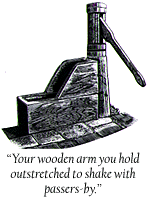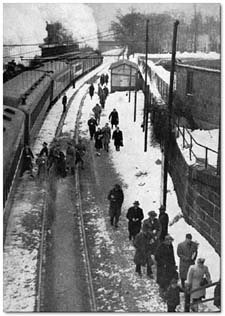
Main Menu ·
Search ·Current
Issue ·Contact ·Archives
·Centennial ·Letters
to the Editor ·FAQs



Hate crowds, long lines, waiting lists? You'd have suffered mightily in
the fall of 1946, when Harvard experienced a population explosion of unparalled
proportions. That year's influx of 9,000 war veterans taxed University resources
and altered the size and character of the institution.
World War II had ended in August 1945. An advance guard of 500 veterans,
their tuition fees and other expenses paid under the G.I. Bill of Rights,
had registered that September. A year later the deluge began. The University's
population soared from 3,600 to 11,700. The size of the College rose from
1,782 to 5,400; the prewar level had never exceeded 3,500. The freshman
class of 2,000 was by far the largest ever. Enrollment in the Graduate School
of Arts and Sciences rose from just over 400 to 1,600, the Business School's
student body went from 70 to 1,400, and the Law School's jumped from 162
to 1,500.
 |
1946: Students housed at Fort Devens arrive by train at Porter Square, Cambridge. Photograph by Walter R. Fleischer
|
The Harvard Alumni Bulletin pondered the plight of the conquering
hero: "After several uncomfortably crowded years in the armed forces,
he is destined for further uncomfortable years at Harvard.Aside from the
inconvenience of living quarters which may be located at considerable commuting
distance from Harvard Square, he will have to be satisfied with crowded
classrooms and all the haste which goes with a University enrollment of
12,000 men, a third larger than the previous peak year. His $60 or $90 a
month will not go so far as a year ago in a community where sodas now cost
25 cents and suits $50; where a single furnished room is $32 a month and
an apartment $75. But he has come, he is welcome, and we wish him the best
of luck. We can take him if he can take us."
American educators had anticipated rising enrollments after the war, but
nothing like this. Student housing was now their number-one problem. President
James Conant sent letters to 16,000 local alumni asking for help in sheltering
some 3,000 married vets and their families. His appeal elicited 99 offers
of space. The widow of an alumnus proffered a room in her Brookline home
for $10 a week. That sum, she explained, would be added to the salaries
of her two maids. Meals and services would be provided; if meals had to
be served at odd hours, they would be. If the cook didn't like the arrangement,
said the widow, she'd fire the cook. Another Brookline homeowner offered
to consign his garage to a naval officer and his wife, provided the wife
washed up for the household. Done and done. Other offerings included a sanatorium
and two country clubs.
Before registration day in 1946, some 300 students who lived within 45 minutes
of Harvard Square were notified that they would have to commute till the
housing crisis abated. The basketball court of the Indoor Athletic Building
was commandeered as a dorm for single students. Each was issued a "cot,
chair, and ashtray."
Almost 200 of the married veterans were housed in 33 one-story frame buildings
shipped by the government from South Portland, Maine, where they had been
erected for wartime shipyard workers. The buildings were reassembled on
lots near the Divinity School, the Business School, and Memorial Drive.
About 400 families bunked at Fort Devens, in the outlying town of Ayer,
a three-hour round-trip train commute via Porter Square station. Their sector
of the army camp was dubbed "Harvardevens Village." Another 115
families lived in apartments at the Hotel Brunswick in Copley Square, which
Harvard leased for three years.
The veterans were eager to learn. Faculty members admired their seriousness
of purpose, disciplined work habits, and broad perspectives. Their differing
economic and social backgrounds, war experiences, motivations, and values
set the vets apart from the relatively homogeneous and more casual student
body of prewar days, and made Harvard a more pluralistic institution. For
the teachers and the taught, the years just after World War II were an exhilarating,
rewarding, often joyous time-crowded quarters and long lines notwithstanding.
~ Primus IV
Main Menu ·
Search ·Current
Issue ·Contact ·Archives
·Centennial ·Letters
to the Editor ·FAQs



![]()
